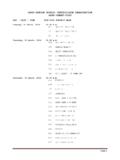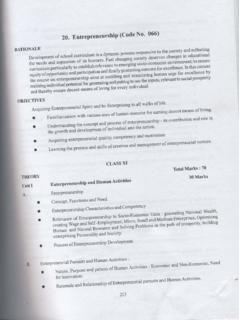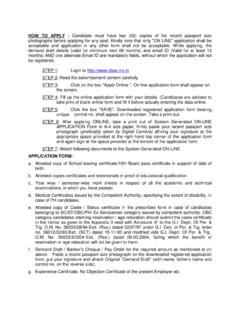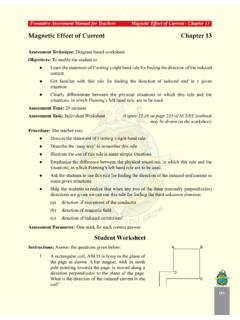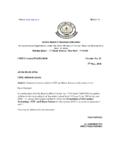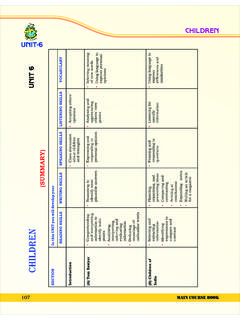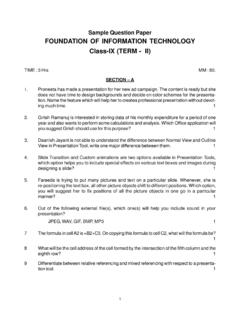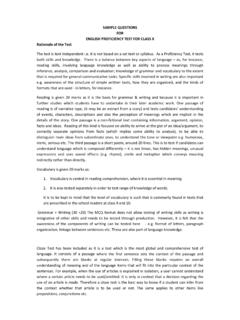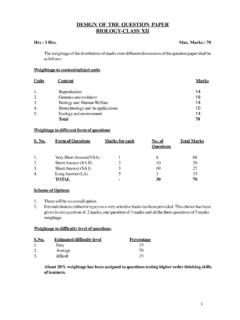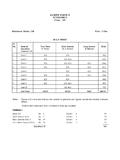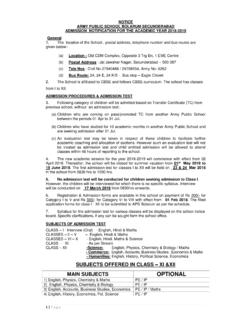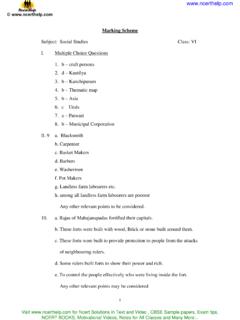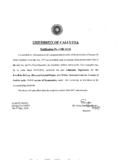Transcription of POLITICAL SCIENCE - CBSE
1 POLITICAL SCIENCE . CODE NO (028). DESIGN OF QUESTION PAPER. SUBJECT : POLITICAL SCIENCE Max. Marks : 100. CLASS XII. 1. Weightage to form of questions Form of Question No. of Marks of Total Marks Estimated Time Questions each question (in minutes). Long Answer (LA) 5 6 30 55 minutes Short Answer (SA) 10 4 40 70 minutes Very Short Answer (VSA) II 10 2 20 30 minutes Very Short Answer (VSA) I 10 1 10 10 minutes 35 100 165 minutes + 15 minutes for revision 2. Weightage of content Part I : Contemporary World Politics Unit Chapter Marks 1. 2. Cold War Era in World Politics Disintegration of the Second World' and the Collapse of Bipolarity } 14. 3 US Dominance in World Politics 4. 5. Alternative Centres of Economic and POLITICAL Power South Asia in the Post-Cold War Era } 16. 6 International Organisations in a Unipolar World 10. 7 Security in Contemporary World }. 8 Environment and Natural Resources 10. 9 Globalisation and its Critics }. Politics in India since Independence 10 Era of One-Party Dominance 11.
2 12. Nation-Building and its Problems Politics of Planned Development } 16. 53. 13 India's External Relations 6. 14. Challenges to and Restoration of Congress System 12. 15. Crisis of the Constitutional Order }. 16. Regional Aspiration and Conflicts 17. 18. 3. Rise of New Social Movements Recent Developments in Indian Politics Weightage of Difficulty Level } 16. Estimated difficult level Percentage Difficult 20%. Average 50%. Easy 30%. 4. Scheme of Options : Internal Choice to be provided in all Long Answer Questions of 6 marks each. 5. In order to assess different mental abilities of learners, question paper is likely to include questions based on passages, visuals such as maps, cartoons, etc. No factual question will be asked on the information given in the plus (+) boxes in the textbooks. 54. BLUE PRINT. Subject : POLITICAL SCIENCE Set I and II. Max. Marks : 100 marks Unit Content/Form of Question Long Answer Short Answer Very Short Answer-II Very Short Answer-I Total (6 marks) (4 marks) (2 marks) 1 (mark).
3 Contemporary World Politics I. 1. Cold War Era in World Politics 6(1) 4(1) 2(2) 14(4). 2. Disintegration of the Second World' and the Collapse of Bipolarity II. 3. US Domination in World Politics 4(3) 2(1) 1(2) 16(6). 4. Alternative Centres of Economic and POLITICAL Power 5. South Asia in the Post-Cold War Era III. 6. International Organisation in Unipolar World 4(1) 2(2) 1(2) 10(5). 7. Security in Contemporary World IV. 8. Environment and Natural Resources 6(1) 4(1) 10(2). 55. 9. Globalisation and its Critics Politics in India since Independence V. 10. Nation-Building and its Problems 6(1) 4(1) 2(2) 1(2) 16(6). 11. Era of One Party Dominance 12. Politics of Planned Development VI. 13. India's External Relations 4(1) 2(1) 6(2). VII. 14. Challenges to and Restoration of Congress System 6(1) 4(1) 1(2) 12(4). 15. Crisis of the Constitutional Order VIII. 16. Regional Aspirations Conflicts 6(1) 4(1) 2(2) 1(2) 16(6). 17. Rise of New Social Movements 18. Recent Developments in Indian Politics Total 30(5) 40(10) 20(10) 10(10) 100(35).
4 Figures outside the brackets show marks. LA 5 Questions 6 marks each Figures inside the bracket show number of questions. SA 10 Questions 4 marks each VSA II 10 questions 2 marks each VSA I 10 questions 1 mark each SAMPLE QUESTION PAPER I. POLITICAL SCIENCE . CLASS-XII. Max. Marks : 100 Time Allowed : 3 Hours General Instructions 1. All questions are compulsory. 2. Question Nos. 1-10 are of 1 mark each. The answers to these questions should not exceed 20 words each. 3. Question Nos. 11-20 are of 2 marks each. The answers to these questions should not exceed 40 words each. 4. Question Nos. 21-30 are of 4 marks each. The answers to these questions should not exceed 100 words each. 5. Question Nos. 31-35 are of 6 marks each. The answers to these questions should not exceed 150 words each. 1. Which event does 9/11 refer to in the context of contemporary world politics? 1. 2. Fill in the blanks: The origin of the European Union can be traced to the Plan sponsored by the to support the European countries to recover from the Second World War.
5 1. 3. Correct and rewrite the following: The UN Security Council has seven permanent members. A majority of the permanent members can veto' any decision of the Security Council. 1. 4. State the full form of CTBT. 1. 5. What was the most important recommendation of the States Reorganisation Commission? 1. 6. What is meant by Planned Development? 1. 7. Name the two leaders who were known for the following two slogans: (a) Jai Jawan, Jai Kisan; (b) Garibi Hatao 1. 8. Match the following four leaders with their parties just before the Lok Sabha elections held in 1977. (a) Charan Singh (i) Congress for Democracy 56. (b) D. K. Barooah (ii) Bharatiya Lok dal (c) Jagjivan Ram (iii) Congress (R). (d) Morarji Desai (iv) Congress (O) 1. 9. Correct and rewrite the following: The Assam Movement was led by religious leaders who demanded the expulsion of non-Hindus from Assam 1. 10. Fill in the blanks: A movement called protested against the building of dam on river Narmada. 1. 11. Identify two arenas of the Cold War with one example each.
6 2. 12. Identify the four countries marked A, B, C and D in the enclosed map given below with Ukraine, Russia, Azerbaijan, Kazakhstan. 2. (A). (B). (C). (D). 13. State any two differences between the economic policies followed by China before and after 1978. 2. 14. Give two suggestions for the reform of the structures and processes of the United Nations. 2. 57. 15. State the two differences between the security challenges facing the newly independent countries of Asia and Africa and the security challenges in Europe. 2. 16. State any two challenges that India faced at the time of Independence. 2. 17. Name the original states from which the following states were carved out: (a) Meghalaya; (b) Gujarat 2. 18. Arrange the following events in the correct chronological sequence, from the earliest to the latest. (a) First Nuclear Test conducted by India. (b) Twenty year Treaty of Peace and Friendship between India and Soviet Union. (c) The Tashkent Agreement between India and Pakistan (d) The Panchsheel declaration by India and China 2.
7 19. State any two characteristics of non-party movements. 2. 20. Identify one similarity and one difference between the crisis in Punjab and Assam during the 1980s. 2. 21. Why did the two superpowers need smaller allies during the Cold War? Give any four reasons. 1x4. 22. What does US hegemony mean in today's world? Mention any two constrains that operate on the US hegemony. 2+2. 23. What according to you is the message of the following cartoon? What do the two wheels in this bicycle represent? 2+2. 58. 24. The Indian Prime Minister is to visit China and you have been asked to prepare a very brief note for him. Write one point each on the Indian and Chinese position on the boarder dispute and economic cooperation. 2+2. 25. What are the four components of the traditional notion of security from external threats? Give one example of each. 1x4. 26. What is meant by Global Commons'? Suggest two steps for protection of Global Commons. 2+2. 27. Identify the four princely states marked in the map given below as A, B, C and D.
8 Mention the major problem faced in the integration of any one of these states into the Indian union. 2+2. 59. 28. Explain any two aspects of India's nuclear policy. 2+2. 29. Was the Congress split in 1969 avoidable? If the split had not taken place, how could it have influenced the course of events in the 1970s? 2+2. 30. What have been the major trends in the electoral performance of the Congress and the BJP since 1989? 2+2. 31. Suppose the Cold War had not taken place and there were several major powers at the end of the Second World War. How would that situation have affected India's foreign policy? Identify any three aspects or regions and imagine the difference. 2+2+2. OR. Suppose the Soviet Union had not disintegrated and the world was still as bipolar as it was in mid-1980s. How would it have affected the developments in the last two decades? Identify any three regions or domains and the developments that may not have taken place in that kind of a world. 2+2+2. 32. Read this extract from the Rio Declaration and answer the following questions: States shall cooperate in the spirit of global partnership to conserve, protect and restore the health and integrity of the earth's ecosystem.
9 In view of the different contributions of the global environmental degradation, states have common but differentiated responsibilities.. (a) Give two examples of the ecosystem being talked about here. (b) Which part of the world has greater responsibility for environmental protection? And why? (c) To what extent was this spirit followed by the states in their action since the Rio Summit? 2+2+2. OR. Read this passage and answer the following questions: If globalisation is about the flows of ideas, capital, commodities, and people, it is perhaps logical to ask if there is anything novel about this phenomenon. Globalisation in terms of these four flows has taken place through much of human history. However, those who argue that there is something distinct about contemporary globalisation point out that it is the scale and speed of these flows that account for the uniqueness of globalisation.. (a) Give an example of each of these four flows that distinguishes globalisation from similar flows in earlier times.
10 (b) Can we conclude from this way of looking at globalisation that it is essentially economic and always positive? Give examples to support your position. 4+2. 60. 33. How was the one party dominant system' in India different from similar systems elsewhere? Did the dominance of one party mean that India was not really a democracy? Give reasons to support your answer. 3+3. OR. What was the green revolution? Which areas did it affect most? Mention two positive and two negative consequences of the green revolution. 1+1++2+2. 34. Argue for or against one of the following proposition: The Emergency showed that the foundations of constitutional democracy are very weak in our country. 6. OR. Indira Gandhi was left with no option except to impose Emergency. 6. 35. Read this passage and answer the following questions: India adopted a democratic approach to the question of diversity. Democracy allows the POLITICAL expressions of regional aspirations and does not look upon them as anti-national.
